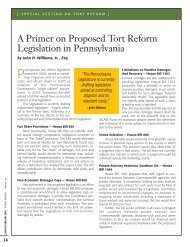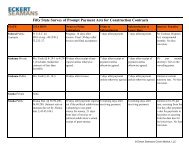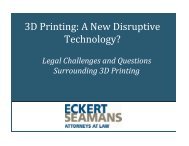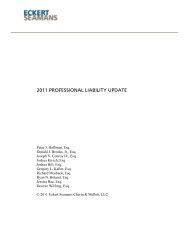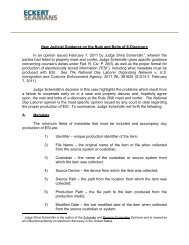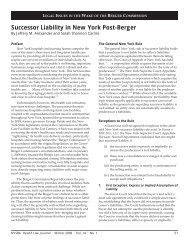2012 PROFESSIONAL LIABILITY UPDATE - Eckert Seamans
2012 PROFESSIONAL LIABILITY UPDATE - Eckert Seamans
2012 PROFESSIONAL LIABILITY UPDATE - Eckert Seamans
Create successful ePaper yourself
Turn your PDF publications into a flip-book with our unique Google optimized e-Paper software.
this non-testifying doctor constituted inadmissible hearsay. The Superior Court agreed, statingthat it had repeatedly held that an expert witness cannot bolster his own opinion by reading intothe record the report of a non-testifying expert who is not available to be cross-examined. In thiscase, the court determined, the non-testifying doctor’s opinion had been elicited from Plaintiff’sexpert for the sole purpose of bolstering the testifying expert’s credibility, and should have beenexcluded. The Court held that a new trial was warranted on the basis of this error.5. Learned TreatisesThe Supreme Court analyzed the extent to which an expert witness may refer to, orutilize, a learned treatise on direct examination in Aldridge v. Edmunds, 750 A.2d 292 (Pa.2000). A defense expert was permitted to support his diagnosis and opinion by referring toexcerpts from medical textbooks. Id. at 294. After a trial and a verdict in favor of allDefendants, Plaintiffs appealed, contending that the trial court erred in permitting the use ofexcerpts from the medical texts. Id. at 296. The court held that learned treatises can be utilizedon direct examination of an expert witness for the limited purpose of explaining the basis for theexpert’s opinion, but the trial court must exercise careful control over the use of such learnedtreatises to prevent the texts from becoming the focus of the examination. Id. at 298; see alsoHyrcza v. West Penn Allegheny Health Sys. Inc., 978 A.2d 961 (Pa. Super. Ct. 2009) (statingthat use of learned treatises may be used on direct examination of an expert witness inappropriate circumstances for the limited purpose of explaining basis for opinion as long asappropriate constraints are imposed by trial court).On its way to reaching its holding, the Supreme Court noted that the Superior Court,whose order it was affirming, had cited the prior Superior Court’s decision in Nigro v.Remington Arms Co., 637 A. 2d 983 (Pa. Super. Ct. 1993), appeal dismissed, 655 A.2d 505 (Pa.1995) for the proposition that texts may be used to bolster or support the credibility of an expertwitness. The Aldridge court also noted that the rationale in Nigro had been that authoritativetexts could be offered as non-hearsay for the purpose of bolstering the credibility of an expertwitness, with the implication that this purpose differed from the impermissible objective ofattempting to prove the truth of the matter asserted. The Aldridge court found this reasoningunsound, and stated it was preferable to recognize the hearsay nature of texts and thatPennsylvania courts have implemented a narrow exception to the rule against hearsay statements,that permits an expert witness to reference treatises on direct examination in order to explain thereasons underlying his or her opinion.6. Expert Qualifications – Medical MalpracticeExpert qualifications are governed by the MCARE Act. Pursuant to MCARE, “no personshall be competent to offer an expert medical opinion in a medical professional liability actionagainst a physician unless that person possesses sufficient education, training, knowledge andexperience to provide credible, competent testimony and fulfills the additional qualifications setforth in this section as applicable.” 40 Pa. Cons. Stat. § 1303.512(a).Under MCARE, in order to be qualified to testify as an expert in a medical liability case,an expert must possess an unrestricted physician’s license to practice medicine, and have beenengaged in active clinical practice or teaching within the previous five years. 40 Pa. Cons. Stat.25



